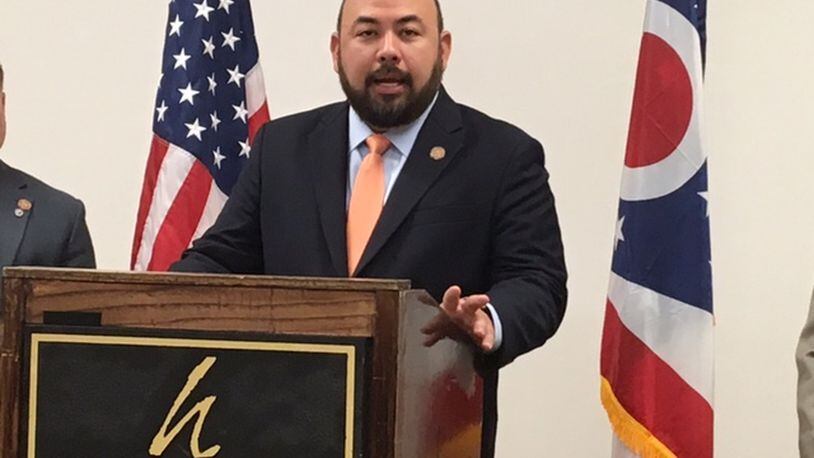“In the future when folks like the Department of Defense look at possible (base closures) and issues that could affect jobs here, we’re better protected,” Rosenberger, R-Clarksville, said at a press conference with fellow lawmakers at the Hope Hotel and Conference Center at Wright-Patterson.
RELATED: Wright-Patt loses out on millions in state dollars
The state will pay $250,000 a year over two years, money advocates say better positions Ohio to compete against other states if Congress pursues a base realignment and closure process, more commonly called BRAC.
“…Even during tight budgets we need to find the dollars to compete with other states who are organized and are devoting their resources to their installations and Ohio needs not just to keep up, but to be a leader,” said state Sen. Bill Beagle, R- Tipp City. Beagle is chairman of the Ohio Aerospace and Aviation Technology Committee.
Putting money in the budget for Wright-Patterson was a victory of sorts after two previous failed attempts. State lawmakers grappling with deficit projections in the hundreds of millions of dollars stripped out a budget request to send $2 million to the Miami Valley base. Prior to that, the Ohio Military Facilities Commission rejected a Wright-Patterson bid for millions of state dollars to help repair infrastructure. The commission chose to split $5 million between two Air National Guard bases in Mansfield and Toledo, upsetting local Wright-Patt advocates.
RELATED: Ohio universities target Air Force lab for research opportunities
State Rep. Rick Perales, R-Beavercreek, had pushed to add $2 million for Wright-Patt to the state budget after the snub. He said Rosenberger explained to state lawmakers “that after being shut out by the Facilities Commission to have a goose egg in the budget sends the wrong message.”
Wright-Patterson spokesman Daryl Mayer said the base was assessing where best to spend the money on infrastructure.
BRAC in 2021?
President Donald Trump submitted a defense budget that asked for a new round of base closures in 2021. The Pentagon has estimated the military has 20 percent more space than it needs.
The House Armed Services Committee recently stripped the BRAC request out of the defense budget the panel sent to lawmakers for a vote, but that would not prevent restoring the provision later, according to Michael Gessel, Dayton Development Coalition vice president of federal programs.
RELATED: Small business contracts way up at Wright-Patterson AFB
After the last BRAC round in 2005, Wright-Patterson added more than 1,100 jobs and gained the 711th Human Performance Wing and the Air Force School of Aerospace Medicine from Texas.
If a BRAC process starts, Ohio should push aggressively to protect the base and show what it has to offer, Perales said.
“The synergy we have from all those organizations over (at Wright-Patterson) is like nowhere else in the country and I personally believe in the last round of BRAC where we won 1,200 jobs and everyone was rah-rah we should have and could have done much better and I think we need to be a little more assertive this time around,” the former Air Force officer said.
Perales is chairman of a state BRAC task force, which expects to release a report on Ohio’s military installations in the months ahead.
“The mission and objective I would say is to get a singular BRAC strategy for the entire state of Ohio which we have never done,” he said.
MORE MILITARY NEWS
RELATED: Aerospace firms compete for Air Force contracts at air show
RELATED: Latest updates on Thunderbird mishap at Dayton Air Show
Loren B. Thompson, a defense industry consultant at the Virginia-headquartered Lexington Institute, said trying to get ahead of a future BRAC through local infrastructure funding “is a smart move.”
“The first step in any closure or realignment decision is to assess deficiencies, so you don’t want to give inspectors an excuse for downgrading your base,” he said in an email. “… A modest investment now can not only protect Wright Patt from downsizing, but attract additional jobs when other bases are targeted for closure.”
More federal research dollars
The money the state set aside for Wright-Patterson was part of $11.5 million lawmakers earmarked in the latest budget for the Ohio Federal Research Network, a state-driven initiative launched in 2015, and defense and aerospace education and workforce-related programs. The network has targeted increasing federal research spending in Ohio through university-based centers of excellence, working more closely with Wright-Patterson and NASA Glenn Research Center labs, and collaborations with private industry.
Dayton Development Coalition President and CEO Jeff Hoagland highlighted the growth in Air Force small business contracts tied to Wright-Patterson over the past few years.
“We’re seeing more work being done in the state of Ohio and in the Dayton region because of the state’s largest single (site) employer,” he said.
According to DDC cited statistics, Air Force Life Cycle Management Center “obligations” to companies in the Dayton region rose about 300 percent between fiscal years 2013 and 2016, reaching $761 million in the most recent year. The totals included multi-year contracts, according to the DDC. AFLCMC is headquartered at Wright-Patterson.
The Dayton Daily News reported in November, Air Force Materiel Command spending on Dayton area small businesses jumped to $223.2 million in 2015, compared to $171.9 million in 2013, figures indicated.
Wright-Patt is the largest single-site employer in Ohio with about 27,000 civilian employees and military personnel with a direct payroll of $2.2 billion and an estimated $4.3 billion total regional economic impact.
COMING SUNDAY
Secretary of the Air Force Heather Wilson talks to this newspaper in an exclusive interview about the biggest issues facing the military branch and how the Air Force’s highest-ranking leaders gathered at Wright-Patterson Air Force Base recently to strategize how to combat threats.
About the Author
